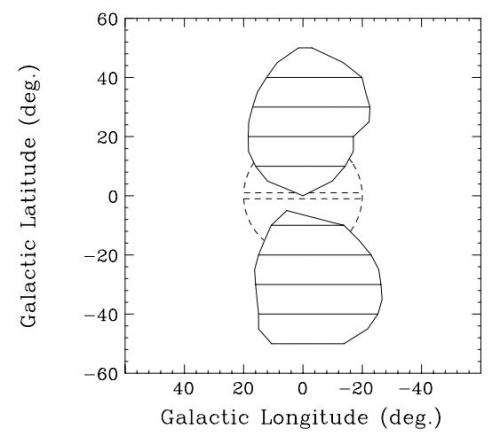March 7, 2013 weblog
Astrophysicists suggest behavior of Fermi bubbles may be explained by dark matter

(Phys.org) —Astrophysicists Dan Hooper and Tracy Slatyer of Fermi National Accelerator Laboratory, and Princeton University respectively, have written a paper—and uploaded it to the preprint server arXiv—in which they suggest that a massive outflow of charged particles from the center of the Milky Way galaxy, may be partly due to collisions between dark matter particles that result in their annihilation. Their research is part of an ongoing effort by various scientists around the world to better explain, or prove the existence of dark matter.
Dark matter, scientists theorize, is matter of a type that cannot be seen, though research suggests it makes up approximately 84 percent of all matter that exists in the universe. No one knows if it really does exist, however, as the term came about to explain gravitational pull on matter that is visible but could not be explained by any other means. Because of that, researchers have dedicated countless hours to its study and to finding real evidence of its existence. In this new effort, the research duo suggest that the massive outflow of charged particles that can be observed stretching above and below the center of the Milky Way galaxy, could be attributed to collisions between dark matter particles, causing their annihilation and the subsequent creation of the building blocks of visible matter—and emitting charged particles as part of the process.
Fermi bubbles, as they are known, are gamma ray outflows of charged particles traveling at nearly 106 m/s. They form what look like two lobes above and below the center of the Milky Way Galaxy. Some of these rays are thought to come about due to the black hole that is thought to exist at the galaxy's center. Likewise, some are also thought to come about due to material given off by stars when they explode. Taken together, however, the identified sources don't add up to produce as many of the charged particles as can be observed. This is because, the researchers theorize, some of the gamma rays are due to dark matter particles running into each other, obliterating themselves in the process. As they do so, they give rise to tau leptons and emit gamma rays. And that, they claim, adds credence to dark matter theory.
More information: Two Emission Mechanisms in the Fermi Bubbles: A Possible Signal of Annihilating Dark Matter, arXiv:1302.6589 [astro-ph.HE] arxiv.org/abs/1302.6589
Abstract
We study the variation of the spectrum of the Fermi Bubbles with Galactic latitude. Far from the Galactic plane (|b| > 30 degrees), the observed gamma-ray emission is nearly invariant with latitude, and is consistent with arising from inverse Compton scattering of the interstellar radiation field by cosmic-ray electrons with an approximately power-law spectrum. The same electrons in the presence of microgauss-scale magnetic fields can also generate the the observed microwave "haze". At lower latitudes (b < 20 degrees), in contrast, the spectrum of the emission correlated with the Bubbles possesses a pronounced spectral feature peaking at 1-4 GeV (in E^2 dN/dE) which cannot be generated by any realistic spectrum of electrons. Instead, we conclude that a second (non-inverse-Compton) emission mechanism must be responsible for the bulk of the low-energy, low-latitude emission. This second component is spectrally similar to the excess GeV emission previously reported from the Galactic Center (GC), and also appears spatially consistent with a luminosity per volume falling approximately as r^-2.4, where r is the distance from the GC. We argue that the spectral feature visible in the low-latitude Bubbles is the extended counterpart of the GC excess, now detected out to at least 2-3 kpc from the GC. The spectrum and angular distribution of the signal is consistent with that predicted from ~10 GeV dark matter particles annihilating to leptons, or from ~50 GeV dark matter particles annihilating to quarks, following a distribution similar to the canonical Navarro-Frenk-White (NFW) profile. We also consider millisecond pulsars as a possible astrophysical explanation for the signal, as observed millisecond pulsars possess a spectral cutoff at approximately the required energy. Any such scenario would require a large population of unresolved millisecond pulsars extending at least 2-3 kpc from the GC.
via ABC
Journal information: arXiv
© 2013 Phys.org



















